http://justrpg.com/reviews/katamari Crayfish are on the Voynich zodiac menu these days, so I thought I would cross-reference some of my previously posted maps and point out additional details about traditions that may have inspired the crayfish symbols in the VMS. Crayfish are quite prevalent in medieval and early Renaissance zodiac art (about 40%), with the rest being crabs.
Çumra In February 2016, I posted a blog about the unusual placement of legs on the crayfish tail, and also included naturalistic drawings of crayfish, showing how different species have different numbers of legs.
In that blog, I pointed out that some zodiacs have a pair of cee shapes on the backs of crayfish/lobsters and some don’t. I’d like to discuss this detail in more depth.
The Lines that Define
You can see the double semi-circles or “cee shapes” on the greenish VMS crayfish on the left and on the medieval calendar-zodiac crayfish on the right:
The crayfish above-right is from Würtzburg (c. 1240s). It is not the earliest example of a crayfish zodiac (an earlier one from Catalonia was described in the previous blog), but it may be one of the earliest to indicate the carapace with curved lines. It has four sets of spindly legs, like the VMS crayfish, but they are correctly placed on the body, not on the tail.
The earliest crayfish zodiacs emerged around the 11th and 12th centuries, in church architecture and manuscript art, but unlike the VMS, the crayfish was typically paired with traditional male Gemini twins.
There are no cee shapes on the crayfish symbols below. Instead, there was sometimes a line running from head to tail. The cee shapes were not yet a popular crayfish motif.
Some details are added by illustrators according to whim, and color (or the direction the figures are facing) is not always a defining feature, but the cee shapes provide an interesting glimpse into zodiac traditions. They appear to have emerged sometime around the 13th century.
Charting the Crayfish’s Carapace
After the c. 1240s Würtsburg symbol, there is a cee-shaped crayfish (c. 1260s) thought to be from Austria. It does not include a romantic Gemini or human Sagittarius, but is similar to the VMS in other ways (non-scorpion Scorpius, no-figure Libra, long-nosed Pisces) and might be considered a “cousin” in terms of motif:
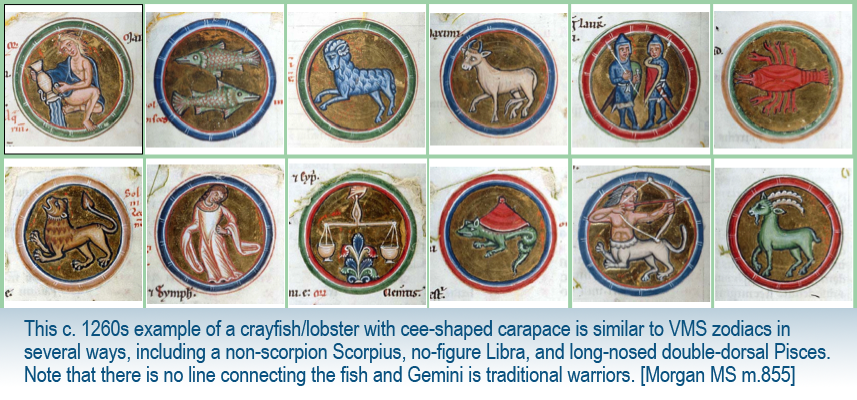 Crayfish with cee shapes are sometimes found in Hebrew manuscripts, such as the Machsor Mazhor (which also has a non-scorpion Scorpius and male/female Gemini). The Machsor Mazhor, in turn, has similarities to Morgan M.855 and BSB Cgm 32. All three were created in the same general region (Austria, or possibly Germany) from c. late 1200s to c. 1340:
Crayfish with cee shapes are sometimes found in Hebrew manuscripts, such as the Machsor Mazhor (which also has a non-scorpion Scorpius and male/female Gemini). The Machsor Mazhor, in turn, has similarities to Morgan M.855 and BSB Cgm 32. All three were created in the same general region (Austria, or possibly Germany) from c. late 1200s to c. 1340:
Geolocating the Crayfish Tradition
In March 2017, I posted a map of the origins of zodiacs that have a crayfish rather than a crab. Unfortunately, I wasn’t able to fit all the examples (some dots are on top of each other), but hopefully there are enough to show that crayfish follow similar patterns to other VMS zodiac symbols, with notable clusters in northeast France and southern Germany, but the examples above suggest there may have been a convergence of traditions a couple of centuries after the earliest examples.
Cee-Shape Crayfish Paired with a More Lizardly Scorpius
The three previous examples have the turtle/tarasque style of Scorpius. The following zodiac is thought to be from France (possibly Provençal, c. 1340). It has a lizard-like scorpion and an interesting detail that is not especially common… Aries, Taurus, and Capricorn have rounded “paws” that aren’t very hoof-like, just as the VMS has unusually rounded hooves. The poses are also similar—note how Aries’s head is drawn from the side and Taurus from a higher perspective so both eyes and horns are visible:
While we’re on the subject of anatomy, look at Aries’s nose. It’s not a very common way to draw it, indistinct and very rounded, so I thought I would post this zodiac from Libr. pict. A 92 (possibly from Germany, c. 1400), which is one of the few that has animals with similarly drawn snouts. They’re not exactly the same, the mouths are more deeply indented, but they are worth noting, since it looks like the hooves on Capricorn might be somewhat rounded, as well:
Variations on Cee-Shape Themes
The following zodiacs, also from France, have similar themes to H 437 (traditional nude twins, a lizardlike Scorpius, centaur Sagittarius, and cee-shaped crayfish) but differ in having a figure holding the scales. Despite the differences in palette and style, they are thematically very similar to each other but, in a sense, one step farther from the VMS. Quite a few northern zodiacs had elaborate frames and traditional nude Gemini behind bushes or behind a shield:
Pairing the Crayfish with Human Sagittarius
The previous zodiacs all have Sagittarius as centaur or satyr. The earliest one I could find that has a cee-shape crayfish and a human archer is Vindo. Pal. 1850 from Prague (c. 1405). Unfortunately, the twins are traditional nude males, and the scorpion is naturalistic, so it’s not quite in the VMS ballpark, but it does have a no-figure Libra:
This 16th-century zodiac from Nuremberg (Cod. Pal. germ 833) has only minor differences and clearly comes from the same tradition as Vindo. Pal. 1850:
False Alarms
It’s easy to get excited about individual images when one first sees them. For example BSB Clm 826 (c. 1390) has a leg-tail Leo with its tongue sticking out, but I was reluctant to post it until I had done more research… I discovered that leg-tail lions are extremely common in medieval art, plus other aspects of Clm 826 are quite different from the VMS. It’s a real scorpion, Virgo has wings, Sagittarius is a satyr, and Taurus is a half-bull emerging from a cloudband. It seems unlikely that the VMS illustrator would copy Leo and completely ignore the other symbols when there are quite a few zodiacs that match the VMS quite well.
Summary
This all adds up to some interesting patterns. The VMS chiefly differs from other cee-shape-crayfish zodiacs in having affectionate male-female Gemini rather than the traditional male twins, yet is more similar overall to zodiacs that don’t include the cee shapes on the crayfish’s back, such as these, thought to be from Augsburg and Cologne:
As can be seen from the above examples, two of the better matches, in terms of motifs, are Morgan MS m.94, which has a line down the crayfish’s back, and Augsburg 2 Cod 5, which has an unusually ornate, decorated crayfish.
Part of the challenge of tracing these traditions is sorting out which details are significant, and which ones are not.
J.K. Petersen
© Copyright 2018, All Rights Reserved

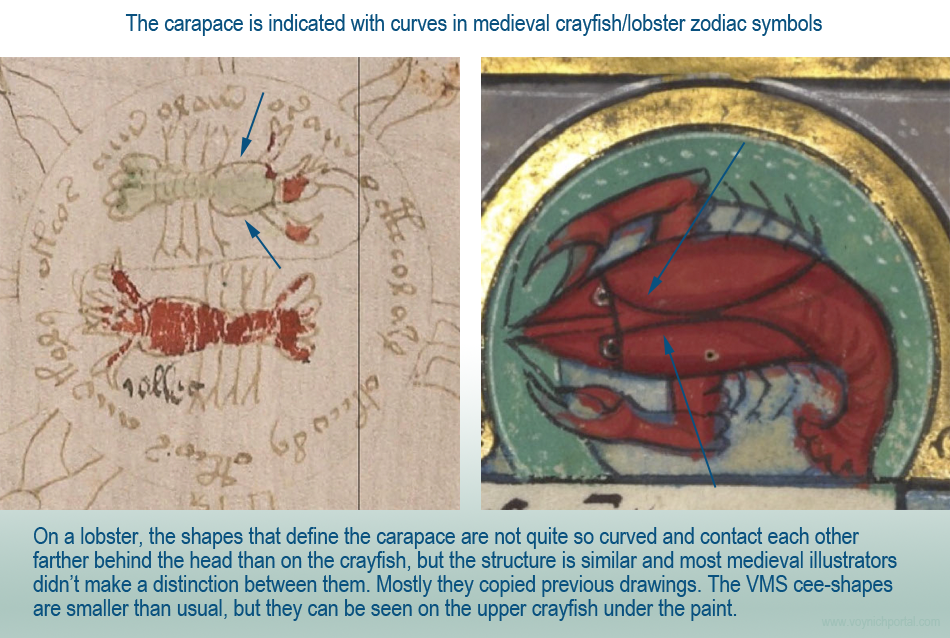
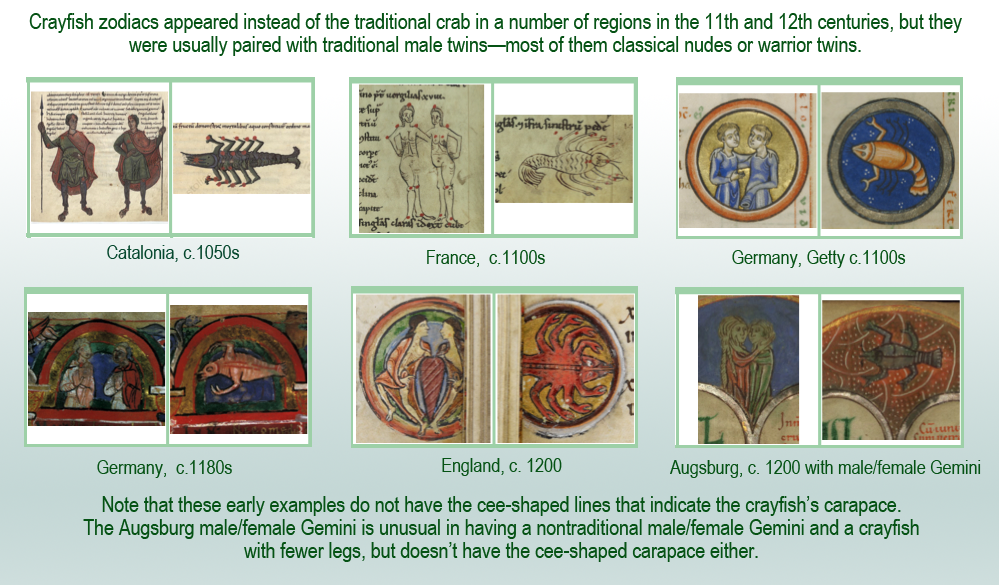
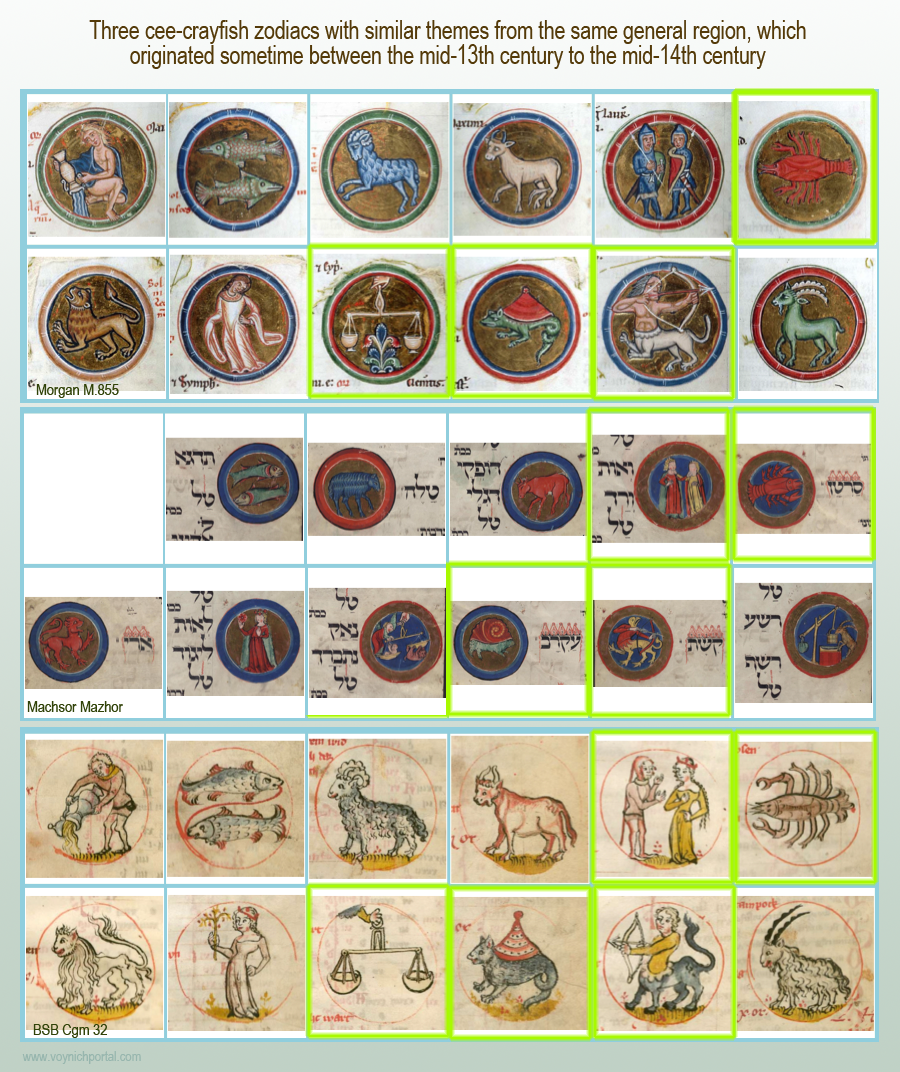
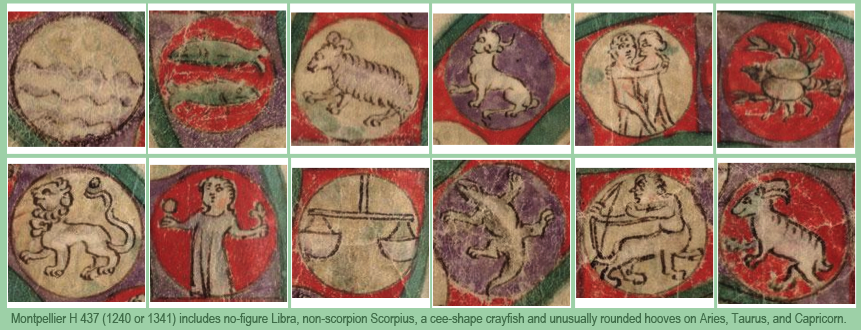
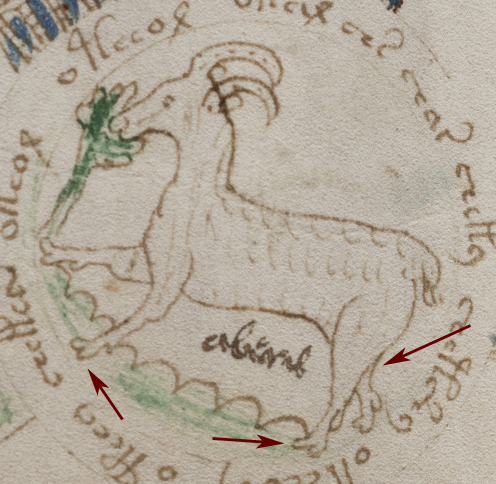
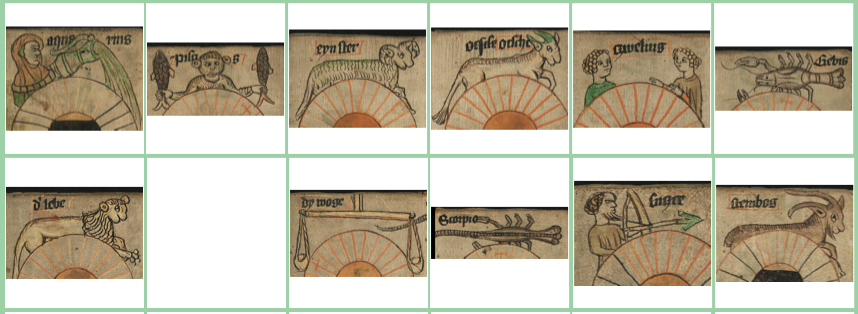
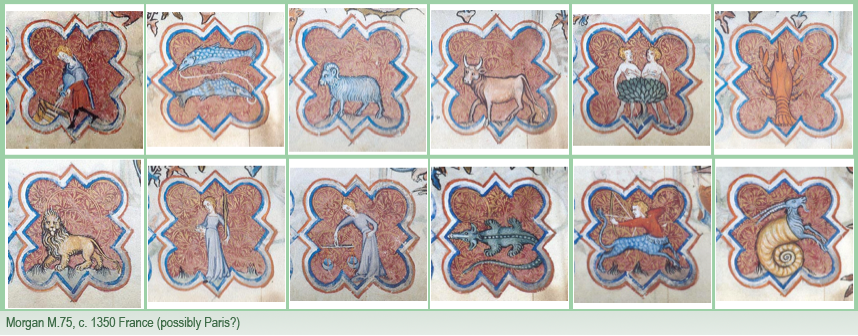
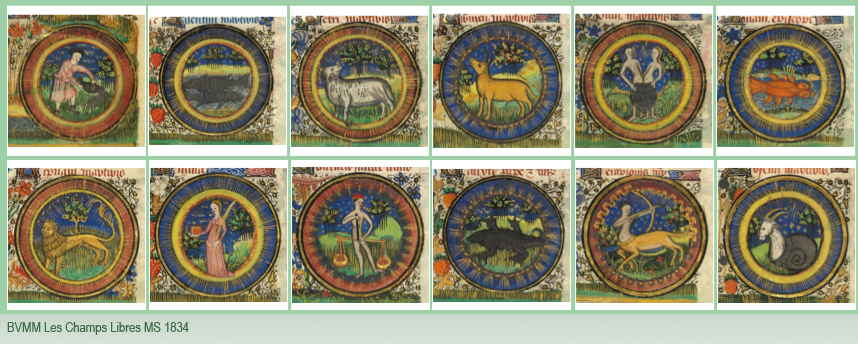
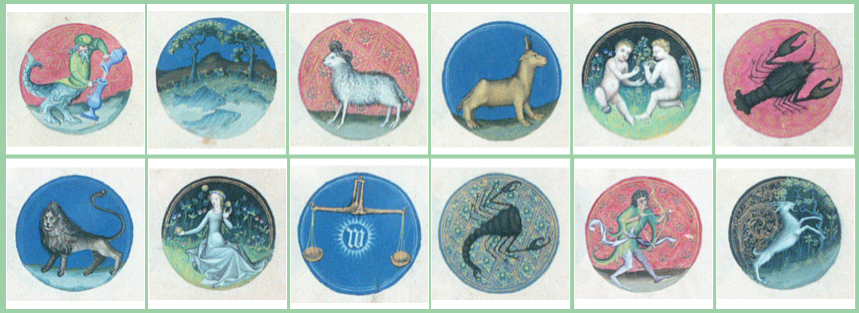
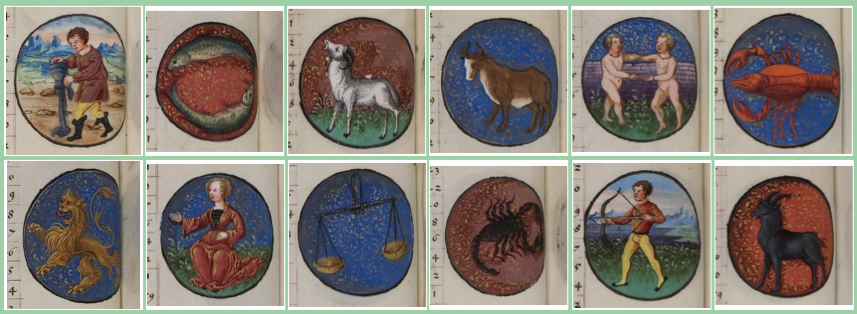
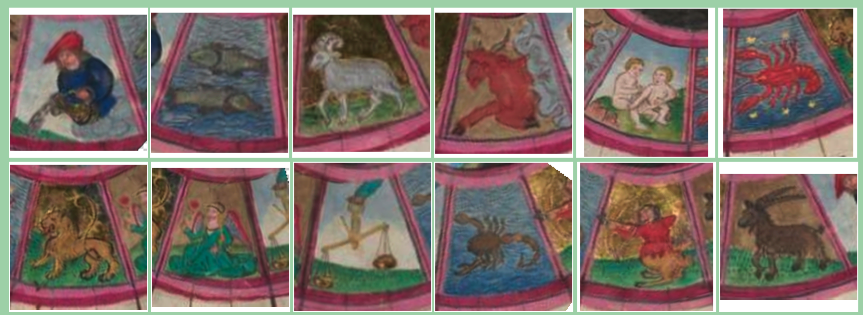
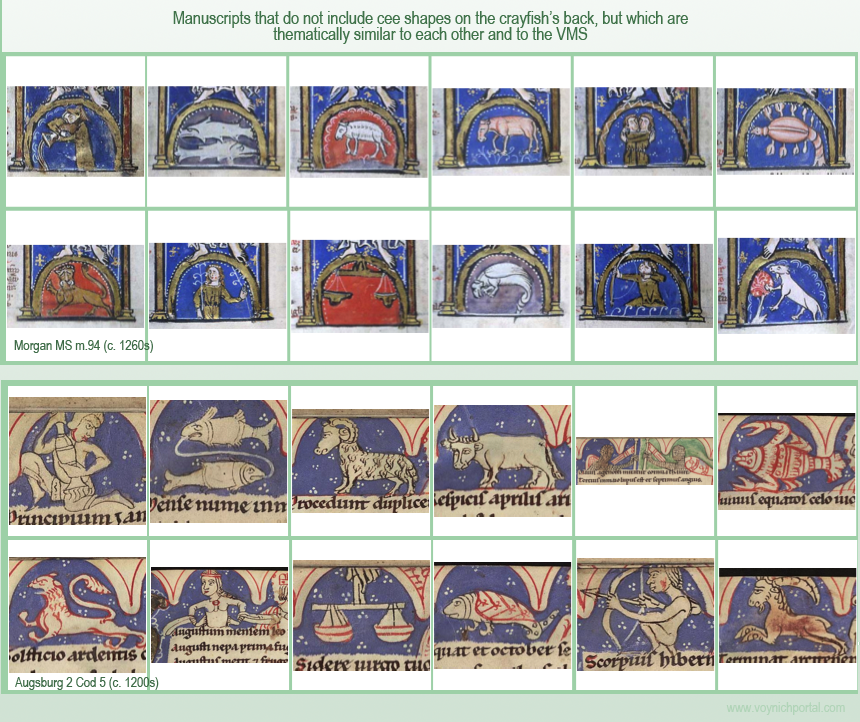
Heh, it’s interesting seeing the VM Aries right beneath the Montpelier Capricorn. If anyone still debates whether the Aries looks like a goat or not they should see that picture.
Dear colleague,
I found very interesting this article. I am a crayfish reseacher and I might have some answers for your questions. Moreover I would like to ask you how to find the comments on the crayfish drawings from catalonia.
Best regards
Javier Dieguez Uribeondo. President of the International Association of Astacology